|

|

Posted January 2015

|
If you have a Civil War item that you can't identify or something you want to know the value of, contact John (mail: Box 510, Acworth, GA 30101;
email John at seantiquing@go-star.com with
Civil War in the subject
line or call 770-329-4984 or 770-974-6495). John needs a good description of the item, condition, manufacturer's marks and any other markings, and photos.
Please Note: All questions MUST be accompanied with a Photo, it should not be more than 200k in file size.
|
|
|
|
Mr. Sexton: Attached is a photo of Carters Gelatino-Albumen box of glass plates with scenes of the Civil War on them. I wanted your take on this item. I belong to the local Civil War roundtable, and one of the first to fall at Gettysburg was one of our own, Lt. Grover.
JS: Your box of photographic glass plates with Civil War photogravures are most commonly known as "magic lantern slides." They were quite popular in late Victorian America and around the world. There are numerous genres of subject material including Civil War scenes, made from photographs, paintings and other media. Before television, radio and even electricity, magic lanterns and their accompanying slides entertained countless families in their parlors in America well into the 20th century—before being phased out by other forms of entertainment.
|
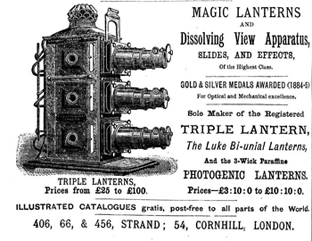
|
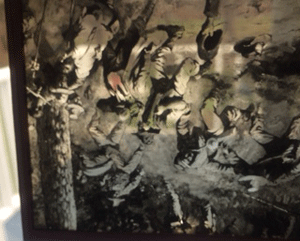
|
|
An ad for a magic lantern.
|
A magic lantern slide of a Civil War painting, $5-$10.
|
Magic lanterns that displayed and magnified these images are usually powered by kerosene flame and were made by many American and European manufacturers. Although scarce, these early projectors are reasonably priced when common examples are found, often under $100; however, rare examples can bring several thousand dollars. Different companies utilized different styles and sizes of slides, so you will find different size images and different styles of holders that these different machines utilized.
The slides are fairly common in auctions, often found in fairly large quantities. Though quite interesting and diverse, the slides rarely bring more than $5 or $10 each in the auction market, and it is not uncommon to be able to buy lots of several hundred for about a dollar each.
|
|
|
I currently have some Civil War swords and a Bardou telescope with stand and case that I would love to see what each item would go for. I currently live in New Jersey. Would you be willing to appraise these few items?
JS: Your swords are an interesting mix. A Japanese katana which, depending on the maker, can be worth much more than the $500-$800 that seems to be a typical auction range for most souvenir samurai swords brought back by GIs in World War II. Your two American swords are much easier to evaluate. The well patinated sword with "US" design in the brass basket hilt surrounded by floral motifs is a typical Civil War US staff and field officer’s sword. This is the regulation pattern that would have been carried by officers above the rank of captain, such as major or colonel. Although not regulation for captains, many Civil War captains carried such a sword.
|
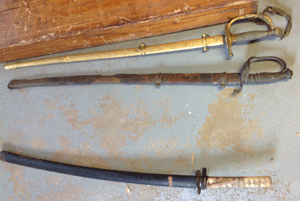
|
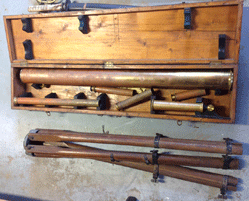
|
|
(Top to bottom) US staff and field officer’s sword made by Collins & Co., $800-$1,200; a U.S. Army model 1840 infantry officer's sword by NP Ames, $2,000-$3,000; and a Japanese katana similar to those brought back from WWII, $500-$800.
|
Bardou & Sons telescope, about $600.
|
Your sword was sold by W. Willard & J.D. Hawley of Syracuse, N.Y., as can be seen on the etched panel on the ricasso. This firm was one of many jewelers and fancy-good dealers that during the Civil War sold swords, military belts, sashes, headgear and other fancy goods for the discerning Union officer who lived in Syracuse, New York. The sword was actually manufactured by Collins & Company, a well-known cutler in Hartford, Ct., in 1862 and is so marked on the blade. The sword has several Collins characteristics, including the engraved "US" and other motifs on the scabbard mounts.
The leather scabbard body is lifting from a metal core, but it still appears solid. In auction, uninscribed, it would probably sell between $800 and $1,200.
The straight-bladed sword with the gold-plated scabbard is a regulation U.S. Army model 1840 infantry officer's sword. This was the sword that foot officers or company-grade lieutenants or captains would have carried. This sword was only regulation for about 10 years and was replaced by a sword similar to your staff officer's sword but with no “US” in the hilt. There are typically only two makers of this particular pattern, one being an import by WH Horstmann of Philadelphia and New York and the other by NP Ames of Springfield, Mass., which this one appears to be a product of. Even without seeing a maker’s mark, which is most likely present on the blade ricasso and possibly on the back of the scabbard, the engraved eagle above a shield between the scabbard mounts is a typical Ames feature.
This sword appears to be in relatively fine condition, though the scabbard has several dents and bends. In today's market, which is quite soft, you could still get between $2,000 and $3,000.
Telescopes are not normally objects I evaluate; however, I did a quick search of several auctions and found that James Julia auctions in Fairfield, Me., sold a very similar, cased Bardou & Sons, Paris-marked telescope on tripod for $632.50 in August 2011. Their description is as follows: “Bardou & Son-Paris brass telescope with stand. 19th century. French. The telescope with 36" barrel, equipped with an adjustable brass mounting bracket and a wheel driven sight adjustment. It is offered with walnut storage case and with an adjustable tripod oak stand. The lens frame engraved with the maker’s name and additionally impressed with a trademark sign. Size: 37" l.; tripod: 51" tall (closed). Condition: case with multiple dents. Lenses appear intact. Case in need of restoration.”
|
|
|
Mr. Sexton, I am submitting this pardon for your free appraisal. It consists of two pages and is stamp-signed by President Andrew Johnson and true signature of Secretary of State W. Seward. The document does have condition issues.
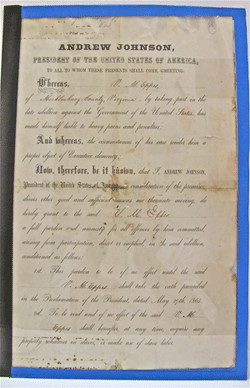 JS: Presidential pardons after the Civil War are not uncommon and usually issued to people of means. Victor M. Eppes (whose name is on the pardon) was no exception. He was a large landowner in Mecklenburg County, Va., having 77 slaves at the start of the Civil War. Indeed, Mecklenburg County had more than 12,000 slaves, making up over 60% of the population. Pardons were important to men of means, as they could then be involved in political and financial dealings with the rest of the country. JS: Presidential pardons after the Civil War are not uncommon and usually issued to people of means. Victor M. Eppes (whose name is on the pardon) was no exception. He was a large landowner in Mecklenburg County, Va., having 77 slaves at the start of the Civil War. Indeed, Mecklenburg County had more than 12,000 slaves, making up over 60% of the population. Pardons were important to men of means, as they could then be involved in political and financial dealings with the rest of the country.
Most of Andrew Johnson's presidential documents are found with a facsimile signature made by woodblock. Johnson was involved in a train derailment just prior to the Civil War, badly damaging his right arm. This injury would limit the use of his writing ability, and actually, signed documents by him are scarce.
Andrew Johnson presidential pardons to ex-Confederates have sold this year at auction for between $100 and $500, with the same woodblock-stamped signatures. Cowan's auction in Cincinnati sold a pardon actually signed by Pres. Johnson for $850 hammer.
These documents are scarcer, but they don't demand a lot of money—unless they are pardoning a famous personality. A pardon for ex-Confederate Gen. Nathan Bedford Forrest sold about 25 years ago for more than $20,000, and it was in poor condition with insect damage.
Andrew Johnson was quite willing to pardon ex-slaveholders and was involved in punitive laws against the newly freed slaves, as we know from history, in contrast to Abraham Lincoln's vision.
Your document would probably have best marketability in Virginia to a collector interested in local history. In a well-advertised auction, it might surpass the auction results mentioned of $100-$500.
|
|
|
John Sexton is an independent appraiser and expert of Civil War memorabilia. He is an accredited member of various appraiser organizations. He can be contacted at 770-329-4984 or www.CivilWarDealer.com. If you have a Civil War item for him to appraise, email a photo and a description to seantiquing@go-star.com
.
|
|
|
|
|
|
|
|